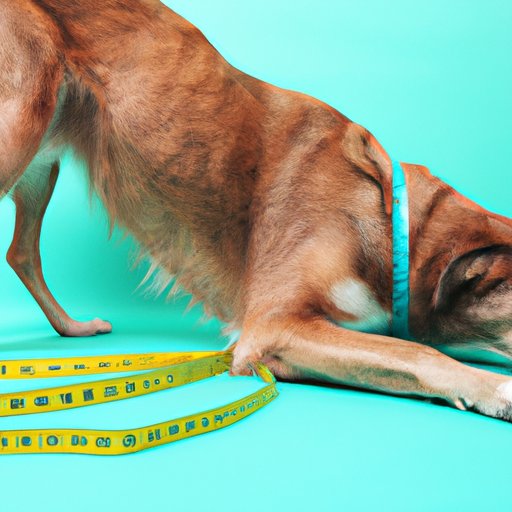
I. Introduction
We all love our furry friends, but sometimes they can become overweight or even obese just like humans do. Unfortunately, many dog owners may not realize the seriousness of this issue until it’s too late.
In this article, we’ll explore the importance of keeping your dog at a healthy weight and offer practical tips for helping your pooch slim down.
II. Doggy dieting 101: Tips for helping your pooch shed those extra pounds
The most effective way to help your dog lose weight is by reducing their calorie intake while still maintaining a balanced and nutritious diet. Here are some tips:
1. Reduce calories: When feeding your dog, make sure to check your chosen dog food’s calorie count before buying it. Often, you can switch to a lower calorie dog food or reduce the serving size according to their needs.
2. Appropriate portion sizes: Use a measuring cup to ensure you’re feeding your dog the right amount, and adjust the portion size according to their ideal weight. You can consult your veterinarian to calculate this amount.
3. Select lower-fat foods: Choose dog food labeled as ‘low fat’ or formulated for weight loss as they can help your dog feel fuller with fewer calories. You can also add vegetables as a side dish instead of treats or table scraps as it can help in making them feel full.
4. Reduction (or elimination) of treats: Reducing or eliminating high-calorie treats will not only cut calories but also encourages your dogs to eat regular meals.
5. Incorporating exercise: Regular exercise can aid your dog’s weight loss efforts and overall well-being. It is an effective way to burn calories, get the heart pumping, and boost your dog’s metabolism.
III. Preventing obesity in dogs: Expert advice for keeping your pup at a healthy weight
Prevention is always better than cure. Here are some tips from veterinarians or other canine experts on how to keep your dog at a healthy weight:
1. Tips and tricks: Experts suggest using treat-dispensing puzzle toys, adding stairs to your home, or walking your dog instead of just letting them play in the backyard to encourage more activity.
2. Certain breeds are prone to obesity: Some breeds, including Labrador Retrievers, Dachshunds, and Beagles, are more likely to become overweight. Be aware of the risks and take steps to prevent surplus weight before it becomes a problem.
3. Calculate your dog’s ideal weight: Know your dog’s breed, age, and gender. You can then calculate their ideal weight using online calculators or consulting your veterinarian.
4. Common mistakes: Not measuring your dog’s food, feeding table scraps, or overindulging with treats are common mistakes dog owners make. Avoid them to prevent your dog from gaining extra weight.
IV. Fun ways to help your dog slim down: Exercise ideas for even the laziest pups
Some dogs may not be excited about exercise, but there are plenty of ways to encourage movement and make it fun. Here are some suggestions:
1. Canine sports: Enroll your dog in agility, flyball, or canine freestyle dance as they’re great for a fun and exciting workout. It’s also an excellent way to bond with your pooch.
2. Toys that encourage movement: Consider investing in interactive toys like frisbees, fetch balls, or tug toys. These toys require your dog to move around and keep them active.
3. Physical activity through simple tricks: Teach your dog some simple tricks like roll over or shake paw as they require movement and can be done while indoors.
V. When to worry about your dog’s weight: Warning signs to watch for
It’s essential to be aware of warning signs and the potential health problems associated with canine obesity:
1. Determine if your dog is overweight or obese: You can check if your dog is overweight by feeling their ribs, spine, and hips. When rubbing their sides, make sure they’re not bulging or protruding.
2. Health problems that can arise: Canine obesity can lead to various health issues such as Type 2 diabetes, arthritis, and even cancer.
3. What to do: If you suspect your dog is overweight or obese, take them to the vet immediately. They can develop a weight loss plan for your pet, and provide guidance on proper nutrition and exercise.
VI. Supporting your dog’s weight loss journey: Strategies for staying motivated and achieving success
Achieving your dog’s weight loss goals can be challenging, but a few strategies can help you stay motivated and on track:
1. The emotional side: Helping your dog lose weight can be an emotional journey. Some owners may feel guilty for letting their pooch gain too much weight. Be kind to yourself and your furry friend throughout this process.
2. Tips for staying motivated: Keep track of your dog’s progress, celebrate milestones, and acknowledge improvements, no matter how small.
3. Overcoming setbacks: Don’t get discouraged if your dog doesn’t lose weight as quickly as you’d like or if there’s a plateau. Just keep going, seek advice from your veterinarian, and adjust the weight loss plan accordingly.
VII. Conclusion
Helping your dog maintain a healthy weight is essential for their overall well-being and longevity. By following these practical tips, including reducing their calorie intake, selecting lower-fat foods, incorporating exercise, and monitoring your dog’s weight, you can ensure your furry friend lives a happy, healthy life. Remember to consult your veterinarian about your dog’s weight and discuss the best possible plan for your dog.





